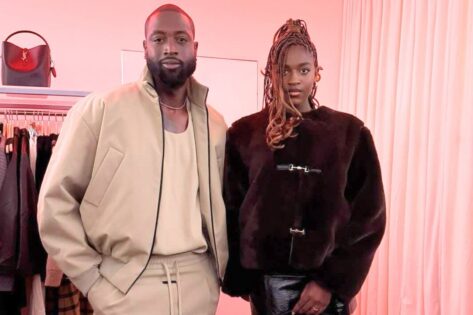At 17, Zaya Wade finds herself at the crossroads of visibility, vulnerability, and vibrant self-expression. She embodies what it means to be young, Black, and trans in a society that frequently attempts to clip those very wings. She balances her days by applying to colleges in the morning, attending fashion week fittings at night, and finding time for skincare, tutoring, and late-night FaceTimes with friends in between. Yet even in the whirlwind, there’s a quiet clarity in Wade’s presence, a sense that everything she does is rooted in something deeper than fame or fortune. Its purpose.
That purpose comes with a weight. “Honestly, what is more impactful than being a transgender teenage girl?” she asked, rhetorically, of course, in a cover feature with Who What Wear.
For Black trans women, adolescence is rarely offered as a gentle thing. The luxury of girlhood—pretty bedrooms, innocent crushes, the silly drama of growing up—is often denied, replaced with scrutiny, judgment, or outright danger. For Zaya Wade, confusion and a lack of language for who she was marked those early years.
“For 12 years, I didn’t have any sense of girlhood,” she shared. And when she did finally come out publicly in 2020, the internet responded not with celebration but with dissection—every outfit, every hairstyle, every movement criticized through the harsh lens of transphobia and racism. Enter Translatable.
A digital arts initiative designed to uplift and empower trans youth of color through creative expression, founded in 2024 by Zaya Wade and her father, Dwyane Wade. At its core, the platform offers a safe, affirming space where young trans people—and their families—can share stories, emotions, and identities through art. Whether it’s poetry, photography, collages, or short films, Translatable celebrates the full spectrum of queer creativity, turning personal expression into collective power. “Seeing people in media who are trans just showing up and processing the courage is activism to me,” said Zaya.
When asked why she chose art as the vehicle for this movement, Zaya Wade’s eyes light up. “Art has always been one of the great monikers of culture. Art is people,” she says. It’s how communities communicate, remember, and heal. For trans people—especially trans youth of color—art becomes a visible declaration of existence. “It’s one of the most visible ways that trans people can show who we are,” she explained. “I think that’s beautiful.”
But art comes in many forms. And Dwyane Wade’s daughter didn’t limit herself to one.
Art, Identity, and Recognition: Zaya Wade’s journey
Zaya Wade shares that dance was her first language of expression—long before she found the words for her identity. As a child, she trained for years, using movement to communicate emotions she couldn’t yet articulate. That connection to the body still informs how she understands and creates art today. “Art isn’t just something you hang on a wall,” she says thoughtfully, her voice softening. “It’s us—our stories, our souls—shown in the way we need others to see them.”
Like many trans youth, especially those of color, Zaya Wade faced overwhelming pressure to “prove” her girlhood. It wasn’t until she embraced the idea that femininity is deeply personal—not performative—that things began to shift. A key influence in that transformation was her stepmother, Gabrielle Union. Known for her fierce confidence and advocacy for marginalized communities, Union gave Zaya the space to explore femininity without limits. “My stepmom has just instilled such a confidence in my femininity. … She was so adamant about telling me that I don’t have to look or act a certain way—I can just be me. And, oh my god, I thank her every day for it,” Zaya said.
Union encouraged her to let go of rigid stereotypes. She embraced the idea that being a girl means feeling at home in your body and voice—not wearing pink dresses or polished nails. It took Zaya Wade years to feel confident in her fashion sense, much less her own skin. For Wade, her first form of fashion-induced gender euphoria came when she slipped on a pair of knee-high boots. “You can’t touch me, both metaphorically and physically, because I’m like 7 feet tall,” she jokes.
Zaya Wade’s impact on the LGBTQ+ community began as a spark and quickly grew into a spotlight. In 2024, her father, Dwyane Wade, won the Elevate Prize Catalyst Award and used the $250,000 grant to help launch Translatable. What began as a family-supported effort has since evolved into a movement led by Zaya’s own voice and vision. In December 2024, Zaya Wade was independently recognized as a Groundbreaker on the Out100 list, a nod to her growing influence and authenticity in the LGBTQ+ movement.
Wade is not waiting for permission to be powerful. She already has what she described as “a whole metropolis” of support, in the form of family, friends, and creative team. And with their never-ending backing, Zaya is stitching together fashion, art, activism, and science into a vibrant tapestry of what trans girlhood can be when it’s held with love. Whether she’s sketching dreams of astrobiology or sketching outfits for the next runway, Wade is rewriting the blueprint for what a Black trans teen can dare to envision.
She’s not just showing up—she’s building futures. Through Translatable, through her unapologetic presence, through her dreams of holding a doctorate in a field that rarely sees girls like her, Zaya Wade is doing more than balancing it all. She’s lifting as she climbs.
“If I can’t see it, I need to be it,” she says. And she is! An artist, scientist, advocate, icon. A walking definition of what happens when purpose meets power.
The post Using Art as Platform, Zaya Opens Up on Award-Winning Initiative With Dad, Dwyane Wade appeared first on EssentiallySports.
